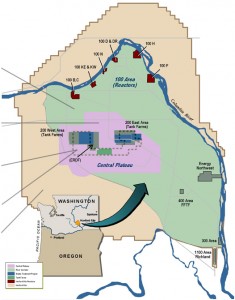Location and management
The Hanford Site is located in the desert of south-central Washington near the City of Richland – approximately 150 miles southwest of Spokane and 200 miles southeast of Seattle. The Site covers 586 square miles and includes an area now designated as the Hanford Reach National Monument. The Site is surrounded primarily by agricultural lands. DOE, the U.S. Fish and Wildlife Service, and the Washington Department of Fish and Wildlife all manage portions of the site.
Unique characteristics of the Hanford Site
The Hanford Site is situated along the banks of the longest continually flowing stretch of the Columbia River (the Hanford Reach), and is home to one of the largest areas of native shrub-steppe habitat remaining in the state. The Hanford Site has unique terrestrial and aquatic ecosystems that are home to forty species of mammals, over two hundred species of birds, and a large variety of amphibians, reptiles, and invertebrates. Rare plant surveys conducted by The Nature Conservancy confirm the site is a critical area for the conservation of rare shrub-steppe, riparian and aquatic plants. At least 725 individual plant species have been identified on site – thirteen of which are listed by Washington State as threatened or endangered. The adjacent Columbia River supports a number of economically and culturally important fish species including the Chinook salmon, coho salmon, steelhead (a federally-listed threatened species), white sturgeon and Pacific lamprey
Recognizing the unique ecological and historical characteristics and importance as a refuge for wildlife, a 195,000 acre portion of the site was designated as the Hanford Reach National Monument by Presidential Proclamation in 2000. Historically, the lands making up the Hanford Site were home to several mid-Columbia Indian Tribes and bands, including ancestors of the present-day Wanapum, Yakama, Nez Perce, and Umatilla people. The Site continues to have tremendous cultural and religious significance for the local Tribes.
Site industrial history
The Hanford Site is home to nine decommissioned nuclear reactors and associated processing facilities. From 1944 until 1987 these reactors produced plutonium for use in the United States’ atomic weapons program. The processes required to transform raw uranium into plutonium generated billions of gallons of liquid waste and millions of tons of solid waste.
Site cleanup
In May 1989, DOE, the U.S. Environmental Protection Agency (EPA), and Washington State signed the Hanford Federal Facilities Agreement and Consent Order, commonly known as the Tri-Party Agreement (TPA). The TPA outlines legally enforceable milestones for Hanford cleanup and compliance over several decades. The TPA is a living document that is regularly reviewed to confirm completion of milestone requirements or to make adjustments in scheduled dates when milestones are to be completed. On November 3, 1989, the EPA placed the Hanford Site on the Comprehensive Environmental Response, Compensation, and Liability Act (CERCLA, or “Superfund”) National Priorities List (NPL).
Ongoing and planned cleanup work at Hanford is expected to address, but not be limited to, more than 50 million gallons of high-level liquid waste in 177 underground storage tanks, 2,300 tons of spent nuclear fuel, 12 tons of plutonium in various forms, approximately 25 million cubic feet of buried or stored solid waste, and approximately 270 billion gallons of groundwater contaminated above drinking water standards, all occurring over an area of approximately 80 square miles, more than 1,700 waste sites, and approximately 500 contaminated facilities. For more information on Hanford cleanup, visit http://www.hanford.gov/.
Please Note: The content provided herein only summarizes the process, laws, and regulations as they pertain to the Hanford NRDA. Please refer to the law and regulations pertaining to NRDA for full description of the process and its definitions and requirements.

